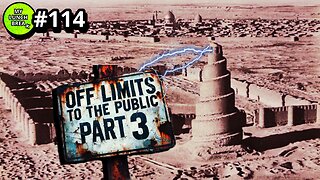Premium Only Content

Pastor Ray Higgins - The truth "they" didn't want told
Pastor Ray Higgins - The truth "they" didn't want told
Source: 《Trooper Buddy》 Trooper buddy
https://www.bitchute.com/video/Bnb2SzCagbcf/
Search.
The earliest known swastika is from 10,000 BCE found in Mezine, Ukraine. The symbol is found in the archeological remains of the Sintashta culture and Indus Valley Civilization as well as in early Byzantine and Christian artwork.
The swastika or sauwastika (as a character, 卐 or 卍, respectively) is a geometrical figure and an ancient religious icon in the cultures of Eurasia. Swastik is used as a symbol of divinity and spirituality in Indian religions. In the Western world, it was a symbol of auspiciousness and good luck until the 1930s
The name swastika comes from Sanskrit word swastik (Devanagari: स्वस्तिक) meaning 'conducive to well being' or 'auspicious'. In Hinduism, the symbol with arms pointing clockwise (卐) is called swastika, symbolizing surya ('sun'), prosperity and good luck, while the counterclockwise symbol (卍) is called sauvastika, symbolizing night or tantric aspects of Kali. In Jainism, a swastika is the symbol for Suparshvanatha – the seventh of 24 Tirthankaras (spiritual teachers and saviours), while in Buddhism it symbolizes the auspicious footprints of the Buddha. In several major Indo-European religions, the swastika symbolizes lightning bolts, representing the thunder god and the king of the gods, such as Indra in Vedic Hinduism, Zeus in the ancient Greek religion, Jupiter in the ancient Roman religion, and Thor in the ancient Germanic religion.
--
Search.
The swastika was a letter in the ancient Sanskrit language. It meant luck or well being. It is also found on Byzantine buildings, Ancient Greek coinage and in Native American burial sites.
--
Search.
The swastika is an icon which is widely found in both human history and the modern world. In various forms, it is otherwise known (in various European languages) as the fylfot, gammadion, tetraskelion, or cross cramponnée (a term in Anglo-Norman heraldry); German: Hakenkreuz; French: croix gammée. In northern Europe it has also been called a sun-wheel. In China it is named wàn 卐 / 卍 / 萬, meaning 'all things', pronounced manji in Japanese. A swastika generally takes the form of a cross, the arms of which are of equal length and perpendicular to the adjacent arms, each bent midway at a right angle.
Sanskrit is a standardized dialect of Old Indo-Aryan. Its linguistic ancestry can be traced back to Proto-Indo-European. The Indo-Aryan migration theory proposes that the Indo-Aryans migrated from the Central Asian steppes into South Asia during the early part of the 2nd millennium BC, bringing with them the Indo-Aryan languages. The main script used to write Sanskrit is Devanāgarī, but it can be written in the scripts of various Indian languages and is sometimes written by the Latin alphabet.
The transition from auspicious svastika to swastika began in the late 19th century following the archaeological investigation of Hisarlik in Turkey by German antiquarian Heinrich Schliemann who believed it to be the site of Troy.
The swastika was long used as a symbol of well-being in ancient societies, including those in India, China, Africa, native America, and Europe.
Adolf Hitler designed the Nazi flag in 1920. He combined the swastika with the three colors of the German Imperial flag (red, black, and white).
(web search it yourself)
DISCLAIMER: I DO NOT OWN THE COPYRIGHTS TO THIS VIDEO/DOCUMENTARY BUT POST IT UNDER THE FAIR USE ACT.
"Fair Use" guidelines:
https://www.copyright.gov/fls/fl102.html
-
 LIVE
LIVE
Vocalot
21 hours agoDay 6! New Here! New Rumble Friends!? 🤙
2,420 watching -
 34:27
34:27
The Connect: With Johnny Mitchell
15 hours ago $10.02 earnedCan He Stop Them? Inside Trumps War On Mexican Drug Cartels & The New Era Of Mexican Organized Crime
25.1K10 -
 2:33:15
2:33:15
Tundra Tactical
7 hours ago $8.11 earnedLuis Valdes Of GOA Joins The Worlds Okayest Firearms Live Stream!!!
27.4K -
 1:03:41
1:03:41
Man in America
16 hours agoAre Trump & Musk the COUNTER-ELITES? w/ Derrick Broze
69K38 -
 3:45:08
3:45:08
DLDAfterDark
7 hours ago $9.04 earnedDLD Live! SHTF Handguns! Which Would You Choose?
38.2K2 -
 1:50:38
1:50:38
Mally_Mouse
9 hours agoSaturday Shenanigans!! - Let's Play: Mario Party Jamboree
48.7K -
 1:13:00
1:13:00
Patriots With Grit
13 hours agoWill Americans Rise Up? | Jeff Calhoun
40K13 -
 14:55
14:55
Exploring With Nug
13 hours ago $10.99 earnedWe Found Semi Truck Containers While Searching for Missing Man!
56.7K7 -
 27:57
27:57
MYLUNCHBREAK CHANNEL PAGE
21 hours agoOff Limits to the Public - Pt 3
126K65 -
 38:07
38:07
Michael Franzese
14 hours agoLeaving Organized Crime and Uncovering Mob in Politics: Tudor Dixon and Michael Franzese
102K15